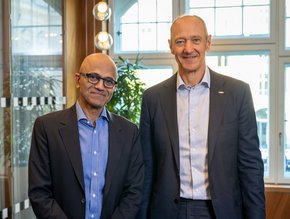Accenture: make the most of tech investments

MAKING the most of tech investments is a key issue for CEOs as every business, whatever the industry, is increasingly turning to technology-based innovation to find the competitive edge.
And the Your Legacy Or Your Legend? report from professional services company Accenture aims to help CEOs get the most out of new technologies as their research, based on the largest survey of enterprise systems to date, shows most are not getting full value from their tech investments.
Having surveyed 8,300 companies, the report shows just 10 per cent were Leaders whose businesses grow revenue at more than two times the rate of the Laggards, those in the bottom 25 per cent of the study group.
Written by Accenture’s Chief Technology And Innovation Officer Paul Daugherty, Group Chief Executive Accenture Technology Services Bhaskar Ghosh, and James Wilson, Managing Director, IT And Business Research, the authors believe most companies are making sub-optimal decisions about how to direct their tech investments.
With C-level executives having to move quickly, they allow business unit, product or geography heads to make decisions affecting their areas which results in highly customised systems operating in isolated pockets of the organisation, gradually becoming ever more difficult to update and modify each system.
The systems are unable to work together at a time when the nature of technology is increasingly dependent on platforms, ecosystems and large varieties of connected data to fuel AI systems, so it means information that might spark enterprise innovation isn’t shared.
Future Systems
The report states: “If they stay this course, CEOs run a real risk of failing. They need to get on a path to Future Systems. It’s a radically different approach – and an innovation and value multiplier.”
According to Accenture, Future Systems are:
- Boundaryless – they blur the boundaries between the IT stack (data, infrastructure, and applications), humans and machines, and organisational and industry silos.
- Adaptable – providing scalability and strategic agility by seamlessly adapting to busines and technology changes, and have flexible, living architectures and new ways to protect and nurture data.
- Radically Human – they empower humans to interact with machines such as through natural conversations and simple touches, and they adapt to humans, not the other way around.
Setting out to determine what an optimal tech investment path should look like, the authors engaged with C-level executives – half were in IT roles – at more than 8,300 companies across 20 industries in 20 countries, including 885 CEOs, to identify those that were getting the most from their investments and those that weren’t.
They collected data on the companies’ adoption of certain technologies, those technologies’ penetration (the extent to which they were in use through the company), and the culture changes (for example, changes in mindset around experimentation and collaboration) that the companies made as they adopted those technologies.
They found Middlers (the middle 20 per cent) grow revenue at more than 1.5 per cent of Laggards (the bottom 25 per cent), but Leaders (the top 10 per cent), grow more than 50 per cent faster than Middlers, and more than twice the rate of Laggards.
In 2018, Laggards left 15 per cent of their annual revenue on the table which will increase to 23 per cent by 2023 in both Leaders and Laggards continue their current trajectories.
Effective Innovation
The report introduces PATHS, the five key decision points CEOs reach when investing in technology where Leaders make the right choice in each area to establish effective innovation models and build Future Systems, and get the maximum value out of their efforts.
PATHS is:
- Progress – How extensively/broadly should we apply new technology to evolve business processes across the enterprise?
- Adaptation – How do we adapt our current IT investments to changing business needs?
- Timing Of Tech Adoption – How do we properly sequence and map our adoption of new technologies?
- Human+machine workforce – How do we activate and enable the workforce to use and be augmented by technology?
- Strategy – How can we intentionally manage the intersection of business strategy and technology strategy?
Leaders pursue the action that will create a building block, allowing the organisation to share and scale innovations repeatedly across business units and processes, while Laggards most often choose easy fixes that create siloed systems, or even fail to decide at all, and Middlers tend to mix and match.
Essential Steps
Accenture has three essential steps to getting started with Future Systems and put your company on the PATHS to innovation, ready to face decisions at every juncture:
- Assess your company’s current position – Identify technology investments specific to processes, geographies and functions. Measure diminishing returns and opportunity costs.
- Reconsider your sunk tech investments – Work with your IT leads to see which can be consolidated or applied across other parts of the business to drive efficiencies and improve returns. Also align around a set of KPIs to track progress.
- Design a new Future Systems strategy – Using the PATHS framework, base it on enterprise-wide needs so it can adapt to the changing nature of employee, partner and customer habits.
NOTES
Accenture’s Future Systems Diagnostic, based on 1.6 million data points from more than 8,300 companies and driven by econometric and decision tree models, can recommend a custom plan for guiding companies in their evolution for future systems, and the full Your Legacy Or Your Legend? Report can be downloaded at https://www.accenture.com/us-en/insights/future-systems/enterprise-innovation-model
For more information on business topics in Europe, Middle East and Africa please take a look at the latest edition of Business Chief EMEA.
- Leadership development remains critical to successLeadership & Strategy
- Five Minutes With: Björn Dufwenberg, MD at Strat7 AdvisoryLeadership & Strategy
- Building bridges between management and productivityLeadership & Strategy
- How analogous inspiration can solve your strategic deadlockLeadership & Strategy






